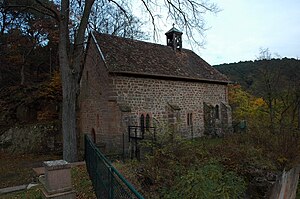Lindenberg Castle (Palatinate)
| Lindenberg Castle | |
|---|---|
|
Chapel of St. Cyriakus, which was built from the remains of the castle |
|
| Alternative name (s): | Lindenburg |
| Creation time : | around 1220 |
| Conservation status: | Burgstall |
| Standing position : | Nobles |
| Place: | Lindenberg |
| Geographical location | 49 ° 22 '52.1 " N , 8 ° 5' 59.7" E |
| Height: | 230 m above sea level NN |
The castle Lindenberg or Lindeburg is an Outbound castle on boundaries of the municipality of Lindenberg in the Palatinate . After its destruction in the 14th century, the Cyriakus Chapel was built from its remains on the same place .
history
Lindenberg Castle was first mentioned in a document with Diemarus von Lindenburch in 1220 , and a chapel in the castle was described in 1286 . Walter von Bruck was in 1334 by his brother Eberhard von Frankenstein with the castle invested , but this was at Engelhard I of already 1,352 Hirschhorn sold. Due to property disputes, the castle came to the Speyer Monastery , but remained a Hirschhorn fief. The castle was destroyed during an inner-German war between Count Palatine Ruprecht I and Engelhard II von Hirschhorn between 1364 and 1371. 1422 received Eberhard III. von Hirschhorn the castle as a fief. The chapel, which has been preserved to this day, was built in 1543. The Bishop of Speyer handed the property over to Friedrich I and Ludwig II von Hirschhorn as a fief in 1611, and in 1633 the castle was transferred from Bishop Philipp Christoph von Sötern to Heinrich von Gournay, Hans Eberhard von Dienheim , Georg Meye and notary Ferdinand Feldgeschrey. The castle has been declared in ruins since 1841. At the beginning of the 20th century, the castle rock was used as a quarry, whereby the last remains of the castle fell victim to this.
legend
According to a legend, Siegfried the Dragon Slayer is said to have come to Lindenburg accompanied by the dwarf king Egwald , with the intention of freeing the captive king's daughter. The castle was guarded by a dragon with seven fiery heads (the mountain was still called Dragon Stone at that time). This dragon was an enchanted person who had to live in this form for seven years. Siegfried, Egwald and his army managed to kill the dragon with their combined forces.
literature
- Ulrich Burkhart, Dieter Barz, Frank Wittkowski: Palatinate Castle Lexicon III I – N. Kaiserslautern 2005, ISBN 3-927754-51-4 , pp. 453-461.
- Viktor Carl: Palatinate sagas and legends. Edenkoben 2000, ISBN 3-9804668-3-3 , p. 160.
